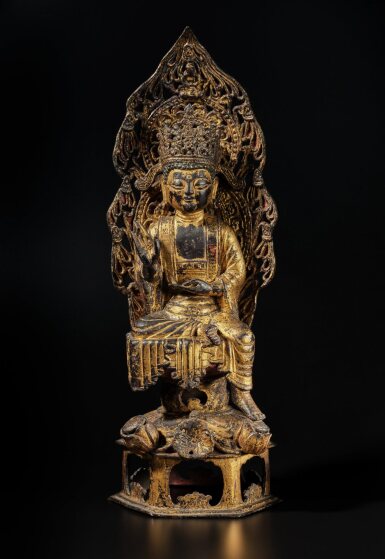Dharma & Tantra
Dharma & Tantra

Property from a Japanese Private Collection
A large gilt-bronze figure of a bodhisattva, Korea, circa 14th century | 朝鮮 約十四世紀 銅鎏金菩薩坐像
Auction Closed
September 20, 03:13 PM GMT
Estimate
300,000 - 500,000 USD
Lot Details
Description
A large gilt-bronze figure of a bodhisattva
Korea, circa 14th century
朝鮮 約十四世紀 銅鎏金菩薩坐像
Height 19¾ in., 50 cm
Christie's New York, 19th September 2000, lot 385 (sold for USD 446,000).
紐約佳士得2000年9月19日,編號385(446,000美元成交)
Chosen kogei kenkyukai auroku [Catalogue of the Korean art research society], Matsuzakaya Department Store, Osaka, 1935, cat. no. 22.
Chosen Kogei Tenrankai Zuroku [Exhibition of Korean Crafts], Chosen Kogei Kenkyukai [Korean Craft Research Committee], 1941, cat. No. 168.
《朝鮮工芸研究会図録》, 松坂屋百貨,大阪日本橋,1935年,編號22
《朝鮮工藝展覧会図録》,朝鮮工藝研究会,1941年,編號168
This rare large gilt-bronze bodhisattva, well preserved and complete with its original pointed and pierced mandorla, was probably created at the dawn of the Joseon dynasty (1392-1910), but encapsulates the restraint, simplicity and refinement of the aesthetics of the Goryeo dynasty (918-1392). The fall of the Tang dynasty (618-907) in China had repercussions throughout the Korean peninsula. In 918, the Unified Silla dynasty (668-935) gave way to the Goryeo dynasty, which was characterized by a certain freedom from hierarchy and authoritarianism. In Buddhist art, this can be seen in a much more flexible, fluid approach to sculpture, as well as a real concern for realism and humanization.
The current bodhisattva appears to represent Avalokiteshvara, and would originally have been placed on the left of an Amitabha triad, with the bodhisattva Ksitigarbha on the right. It is rare to find a gilt-bronze figure of a bodhisattva of this large stature. For another seated gilt-bronze figure of a bodhisattva, see a smaller (16cm high) figure of Mahasthamaprapta in the collection of the Horim Museum, Seoul (accession no. 1047), attributed to the late 14th century. A closely related figure of Ksitigarbha is also illustrated in Korai Richi no bukkyo bijutusu-den [Study of Korean Koryo-Dynasty Buddhist Art], Yamaguchi Prefectural Museum, Yamaguchi, 1998, cat. no. 48. For a complete bronze Amitabha triad from the Joseon dynasty, see the example formerly in the Worcester R. Warner Collection and now in the Cleveland Museum of Art (accession no. 1918.501), illustrated by So-young Lee et al., Art of the Korean Renaissance, 1400-1600, Metropolitan Museum of Art, New York, 2009, cat. no. 13.
The dating of this lot is consistent with the results of a thermoluminescence test, Oxford Authentication Ltd., no. N100u62.
本拍品經牛津熱釋光檢測編號N100u62,結果與其斷代相符
